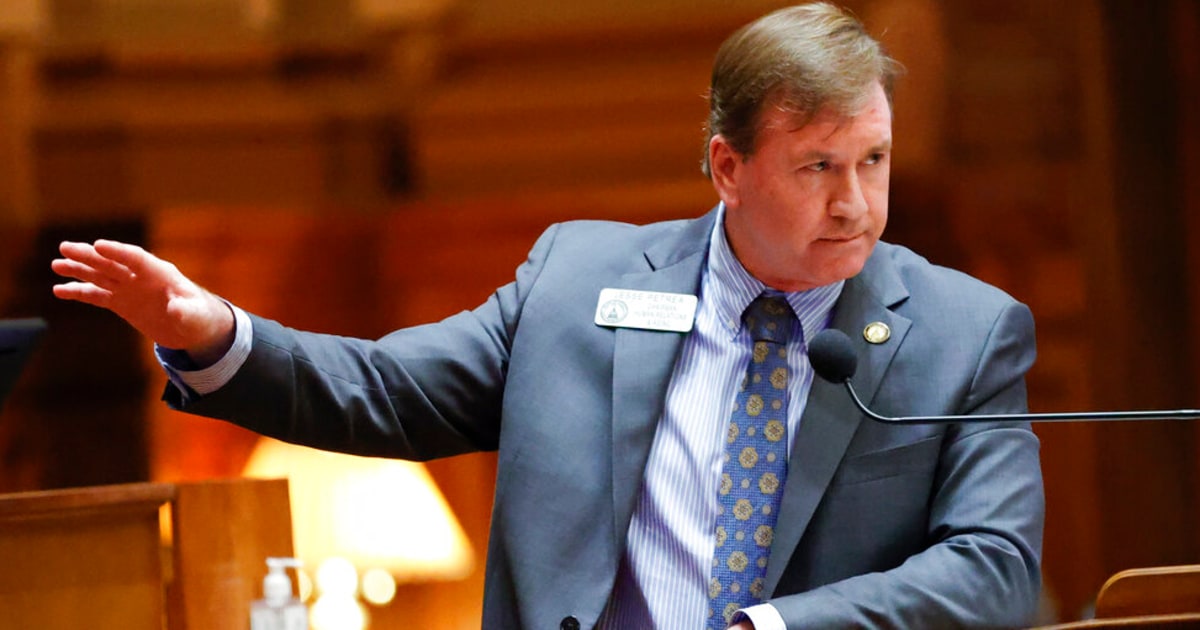Icon: enlarge
Following the murder of Sarah E. in London, protest movements are calling for better protection measures for women
Photo: Drew Angerer / Getty Images
Sarah E. headed home on March 3, 2021 after visiting a friend in south London.
The 33-year-old marketing manager was last seen alive near a park in Clapham at nine o'clock in the evening - she had even spoken to her boyfriend on the phone.
A few days later, her body was found.
The alleged perpetrator who is said to have kidnapped and murdered her: a police officer.
The anger in Great Britain is so great precisely because any woman could be Sarah E.: According
to a study commissioned
by
"
UN Women UK
"
, more than 80 percent of British
women between
the ages of 18 and 24 have already experienced sexual harassment in public places experienced.
Movements like "Reclaim these Streets" are currently organizing protests, holding virtual vigils and calling for better measures to protect women.
Icon: enlarge
Most British women have been molested in public places
Photo: Richard Baker / Corbis / Getty Images
The fears and experiences women have under hashtags like #ReclaimtheseStreets
share in social networks, women all over the world know: How they feel persecuted as soon as a man runs behind them, how they prepare for attacks with keys or pepper spray or take detours to avoid dark corners.
Women's movements, which are gaining popularity, are increasing the pressure on governments to act more consistently against violence.
But how can cities be made safer for women?
Promising concepts from London, Vienna, Bangkok and Ciudad Juárez show how public space can be better designed for girls and women: with adequate lighting in squares and in parks, easily visible streets, bus and train stations.
But also with special training for bus drivers and police officers.
And with the help of technical aids such as apps, users can view safe routes through the city or report incidents.
The examples show: One thing is that women can move around more safely in cities
Task for politics and town planners, but also for society as a whole.
Icon: enlarge
Conventional navigation apps often lead women into unsafe areas
Photo: Jorge Sanz / SOPA / LightRocket / Getty Images
The example of London, already one of the cities with the highest camera density in the world, shows that technical surveillance alone does not help: According to "Comparitech", London even overtakes Beijing with 68.4 cameras per 1000 inhabitants - attacks still occur.
After the murder of Sarah E. British Prime Minister Boris Johnson doubled the budget for better lighting and surveillance cameras, with a total of 52 million euros now available.
"Surveillance is currently being discussed as one of the supposedly best tools to prevent violence against women," criticizes Jillian Kowalchuk.
"Research shows, however, that cameras are not particularly effective for prevention, but rather, as in Sarah's case, help to identify and find perpetrators."
Icon: enlarge
Jillian Kowalchuk developed the "Safe & the City" app to prevent harassment
Photo: Safe & The City
The 35-year-old Canadian who lives in London has developed an app that helps women across the UK and Berlin navigate the city more safely.
“Safe & the City” helps them avoid potentially dangerous places and documents where there has been a lack of lighting.
The app collects bad, but also good experiences in order to calculate better routes: users are asked to rate how safe they felt on their way - and they should report sexual harassment, other assaults and grievances.
The app has documented around 30,000 such incidents so far.
Women can use the emergency button to alert the local police directly - a few hundred users have already made use of this.
"Dead-end situations that are difficult to see should be avoided"
Small interventions such as more street lights can make cities safer for women in some places - ideally, however, the protection aspect is integrated into urban and post-traffic planning and financial decisions from the outset.
The concept of “gender mainstreaming” aims to achieve equality in all areas and change traditional urban planning: “The experiences of women in urban life and their special needs were always just an afterthought, because most city planners and politicians were and are men,” says Leslie Kern, author of »Feminist City«.
Women are more dependent on local public transport than men, but mayors tend to invest more in building roads than in footpaths and public transport.
Underpasses also allow traffic to flow better - but tunnels can become traps and frighten women.
"Badly visible, little-frequented dead-end street situations as well as optical cul-de-sacs, i.e. sharp curves or exits hidden by pillars, should be avoided," says a paper from the City of Vienna on gender-sensitive traffic planning.
Vienna has been implementing the “gender mainstreaming” concept for 15 years: women are involved in decision-making in managerial positions and as experts, and residents are asked about their wishes for new projects.
In the case of projects, the city calculates the different consequences for the everyday life of women and men - and also distributes the public budget more fairly.
Unobstructed view: women should also feel comfortable in Viennese parks
Photo: Peter Zelei Images / Getty Images
The city has widened many footpaths, expanded public transport and redesigned green spaces such as the Einsiedlerpark in such a way that girls also feel safe there.
The basketball court, which used to be dominated by young men, was divided into two playing areas, and new facilities such as hammocks were added.
In addition, the main access routes to the park were widened and the lighting improved.
Bus drivers as "eyes of a city"
Thailand's capital Bangkok, with its 15 million inhabitants, has also been trying for years to make the streets safer for women.
There, bus and taxi drivers as well as conductors are specifically involved.
The idea: anyone who sits behind the wheel of public transport or carries out ticket checks in the subway has their eyes literally on the streets and in the tunnels of the metropolis - and is the first to know when a woman is in danger.
Icon: enlarge
Bus drivers are supposed to protect women in Thailand from harassment
Photo: DIEGO AZUBEL / EPA-EFE
For two years, employees of the state bus company The Transport Company have been trained to recognize when passengers are being sexually harassed.
You will learn how to de-escalate or interfere without endangering yourself or others.
The company put QR codes on the seats of the means of transport that women can use to report assaults.
More than 300 buses are also equipped with special videos, comparable to the safety videos that are shown in aircraft before take-off.
The films on the Bangkok buses are primarily intended to sensitize men to the topic and to motivate them to intervene and report cases.
Because, as experience reports and studies show, camera surveillance is important in subway tunnels and means of transport - but the decisive factor is often the rapid intervention of uninvolved people in order to stop or even prevent attacks.
Emergency telephones and training for the police
In Mexico, the capital of feminicide, the border metropolis Ciudad Juárez, has just developed a gender-sensitive focus strategy that is to serve as a model for other cities in the future.
The city's women's institute was built in the middle of the dilapidated old town, near the red light district and the border crossing - where a particularly large number of women are kidnapped, forced into prostitution and harassed.
Icon: enlarge
Demonstration on International Women's Day: Thousands of women have been murdered in Ciudad Juárez in recent years or have disappeared without a trace
Photo: David Peinado / NurPhoto / Getty Images
The »Corredor Seguro«, a security corridor, is to be built around the institute.
The police can be alerted at emergency telephones and public, monitored toilets are available for girls and women who flock to school and work across the border every day - so that they no longer have to use the facilities of dodgy bars or restaurants.
The police should also be more present: more female police officers are stationed in the center, and the Women's Institute, together with the local university, has developed a 120-hour theory and practice course that sensitizes the security forces to violence against women.
Around 80 civil servants have already completed the training.
"You learn to see and deal with incidents in a different way," says Institute Director Verónica Corchado.
"When a man and a woman have quarreled or fought, they used to assume that there was something between the two of them or that they were both perpetrators - now they separate the two immediately and give women the chance to explain themselves."
Icon: The mirror
This contribution is part of the Global Society project
What is the Global Society project? Up arrow Down arrow
Under the title Global Society, reporters from
Asia, Africa, Latin America and Europe
report on injustices in a globalized world, socio-political challenges and sustainable development.
The reports, analyzes, photo series, videos and podcasts appear in the international section of SPIEGEL.
The project is long-term and will be supported by the Bill & Melinda Gates Foundation (BMGF) for three years.
A detailed FAQ with questions and answers about the project can be found here.
What does the funding look like in concrete terms? Up arrow Down arrow
The Bill & Melinda Gates Foundation (BMGF) is supporting the project for three years with a total of around 2.3 million euros.
Is the journalistic content independent of the foundation? Up arrow Down arrow
Yes.
The editorial content is created without the influence of the Gates Foundation.
Do other media have similar projects? Up arrow Down arrow
Yes.
Big European media like "The Guardian" and "El País" have set up similar sections on their news sites with "Global Development" and "Planeta Futuro" with the support of the Gates Foundation.
Have there already been similar projects at SPIEGEL? Up arrow Down arrow
In recent years, SPIEGEL has already implemented two projects with the European Journalism Center (EJC) and the support of the Bill & Melinda Gates Foundation: The "Expedition The Day After Tomorrow" on global sustainability goals and the journalistic refugee project "The New Arrivals", as part of this several award-winning multimedia reports on the topics of migration and flight have been produced.
Where can I find all publications on Global Society? Up arrow Down arrow
The pieces can be found at SPIEGEL on the topic Global Society.










/cloudfront-eu-central-1.images.arcpublishing.com/prisa/KMEYMJKESBAZBE4MRBAM4TGHIQ.jpg)


/cloudfront-eu-central-1.images.arcpublishing.com/prisa/EXJQILQR5QI7OMVRTERD7AEZAU.jpg)
